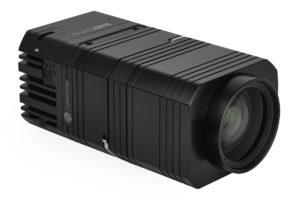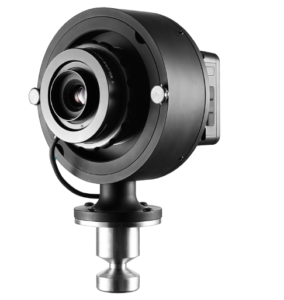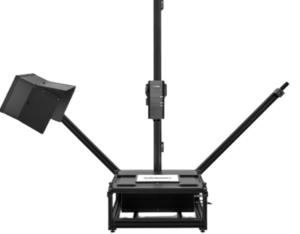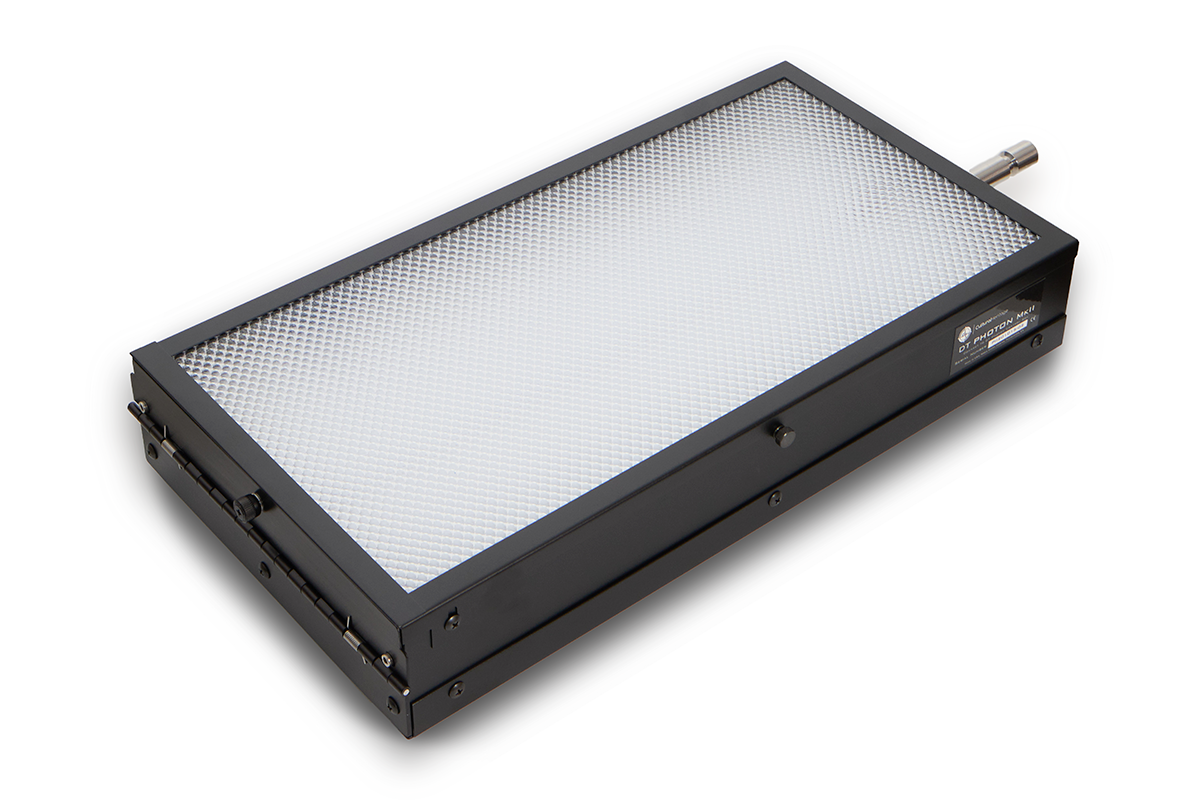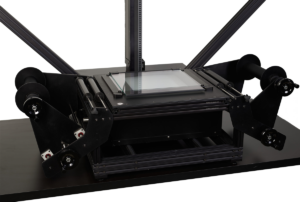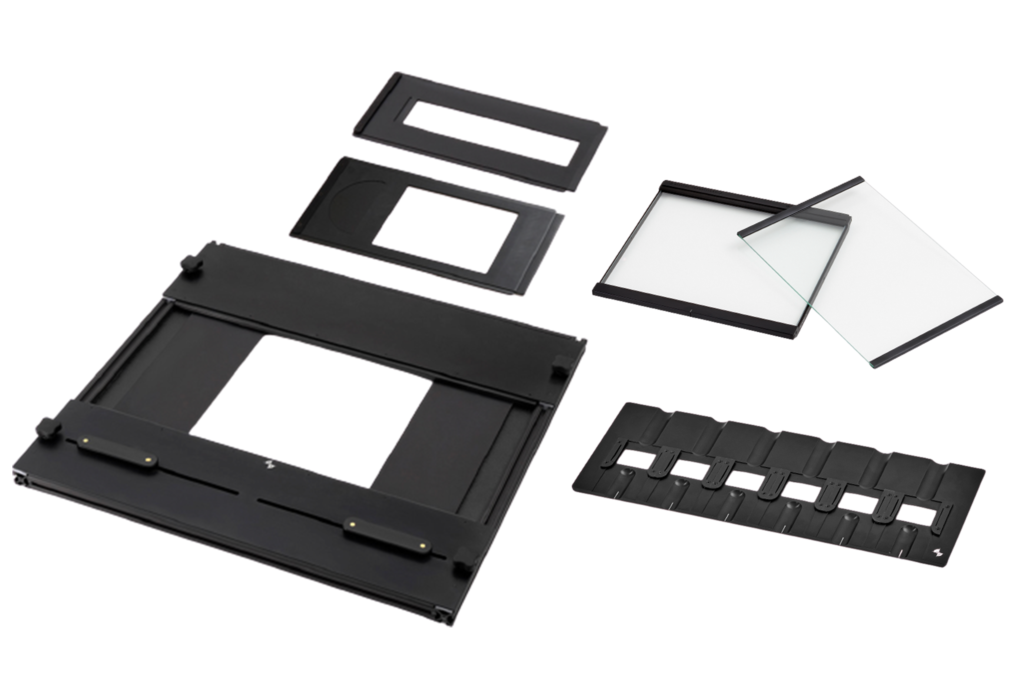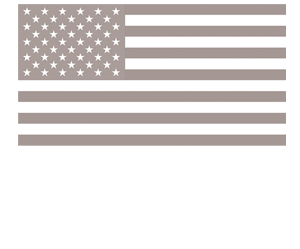Film Scanning Knowledge Center
Digitizing transmissive materials at the highest possible quality can be an intimidating task, so we built this resource to guide you through it. Whether you’re aiming to meet image quality standards like FADGI or just looking to get the most detail out of your personal collection, you’re in the right place. Dive in for hardware and software solutions, project planning tips, handling considerations, video resources, and much more!

“Migratory workers returning from day’s work. Robstown FSA (Farm Security Administration) camp, Texas,” digitized by the Library of Congress
Our Commitment To Preserving The Photographic Process
Photography is a young medium, invented less than 200 years ago. In this short time span, we have seen diverse photographic processes, materials, and chemistry that challenge cultural heritage conservation and digitization. Our collective film scanning knowledge, gained with the support of our Cultural Heritage and Photographic community, has grown over the past years, and we decided to share this information by creating this resource to serve our community.
By no means is this Digital Transitions Knowledge Base attempting to be an exhaustive resource for the scanning of photographic film types produced throughout history. However, we have all seen that scanner manufacturers have fallen victim to the fact that the vast majority of new photographs are born digital and the commercial need for film scanners is limited to a smaller and smaller user base.
We welcome your feedback and contributions to this resource to help store collective information across the topic of film scanning. I personally think this is a timely resource as the craft of making high-quality images from photographic films may become lost to future generations of photographers, imaging professionals, and those entrusted to steward analog photographic collections. Please dive into the information below and contribute by contacting us via the form at the bottom of this page.
Sincerely,
Peter Siegel, Founder of DT Heritage
Conservation Handling
Transmissive materials always require delicate handling and as materials age, they often become even more difficult to manage. Film naturally attracts dust and fingerprints, is prone to scratching, and can react adversely to light, heat, and humidity. To avoid potential damage, operators must be equipped with the proper tools and training for these challenges. One of the most common sources of damage is with hardware that automatically feeds film into the digitization system or holder. Proper conservation handling should be completely user-managed.
Production Speed
Film collections commonly contain hundreds or thousands or millions of items. Safety and image quality are always our top priorities, but production speed has to remain high as well. Digitization departments should be equipped with hardware that uses instant capture technology rather than legacy scanning methods, and use software that automates repetitive, tedious tasks to optimize operator time.
Quality and Flexibility
Film archives often contain several different film formats and emulsion types — how can we maintain consistent image quality across such diverse collections? Legacy scanners were poorly equipped to answer that question, often limiting material sizes and lowering resolution as materials grew larger. Modern digitization platforms should be well-equipped to meet and exceed FADGI 4 Star standards for any and all film formats.
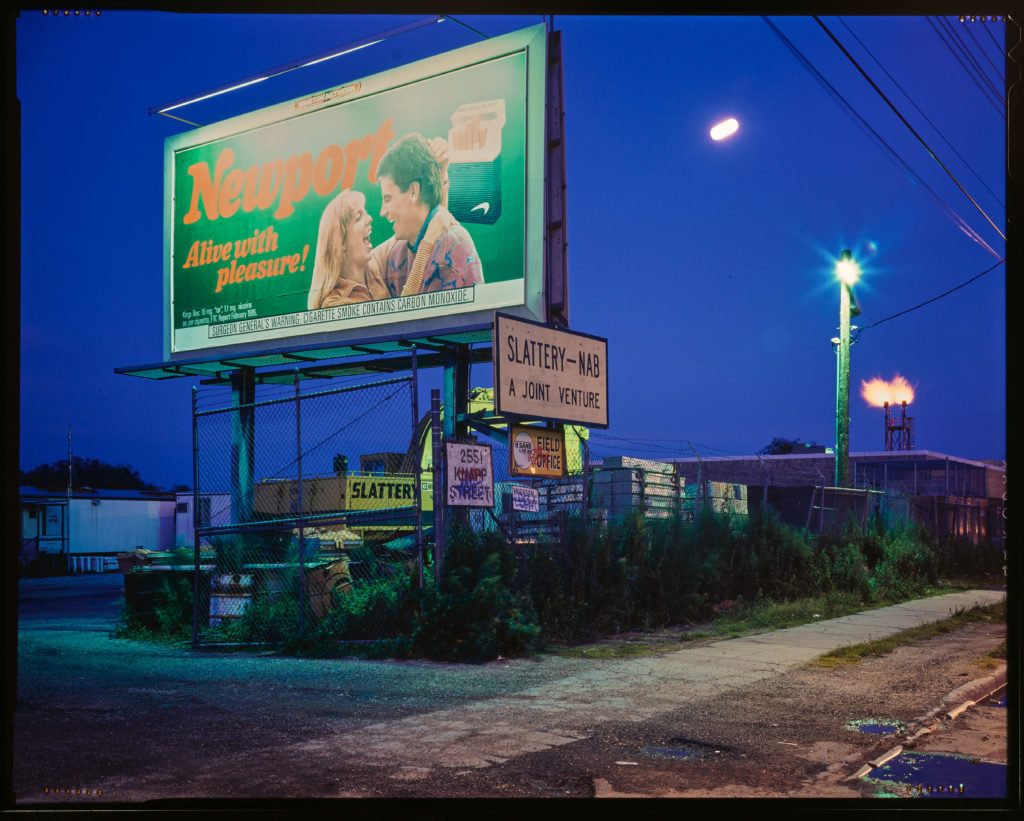
“Untitled Photo,” digitized by DT Heritage
How do we overcome the challenges in film scanning?
Digital Transitions preservation-grade solutions are up to the task.
Drum scanners were the gold standard for film scanning for decades. However, our modern film scanning solutions are able to exceed the resolution and dynamic range set by that standard.
Phase One iXH
The Phase One iXH is a purpose-built camera designed uniquely for Cultural Heritage digitization. The iXH 150MP’s robust sensor enables it to exceed FADGI 4 Star image quality specifications for all material types, including film and transmissive material. In addition to being the highest-resolution camera commercially available, the iXH is engineered to seamlessly integrate with digitization workstations such as the DT Atom, Element, Versa, or Titan.
DT RCam
While the vast majority of use cases can be covered by the resolution provided by the iXH, in some scenarios even higher resolution is required, and the DT RCam delivers it, allowing for up to 12,000 PPI resolution. The RCam is a versatile reproduction camera designed to work with a wide variety of digital backs to make certain you can utilize the best back for a variety of film types. The RCam features manual capturing options that produce high-quality scans with the right skills. This camera is great for users who are looking for more cost-effective options without compromising image quality.
DT Atom
The DT Atom is the most versatile digitization system in the world. Small, efficient, and FADGI 4 Star ready, it is configurable for any material type. The DT Atom excels at scanning all types of transmissive material and is fully compatible with the DT Film Scanning Kit and Reel Film Top. Its removable lights allow the Atom to transform image both transmissive and reflective material, and its seamless integration with our Film Scanning Kit allows two operators to scan up to 300 slides per hour.
System Accessories
Essential components for preservation-grade film scanning.
DT Photon Mk II
The DT Photon Mk II series is the only lighting designed specifically for Cultural Heritage imaging and color reproduction. They provide preservation-grade spectrally accurate color reproduction, conservation-friendly UV-filtration and operating temperature, and industrial-grade build quality for longevity. The DT Photon can also be placed under objects such as film or glass plates to provide transillumination. It fits in the interior cavity of the DT Atom or placed on the tabletop of any copy stand and used as the object-bearing surface; the top surface runs at 92 degrees Fahrenheit (33C), the same as a human hand.
DT XY
The XY allows contact-free scanning using included magnetic holders. No wet mounting, no automatic feeding mechanism, no film bending. Trusted by the Library of Congress for handling their most valuable one of a kind collections. With extreme resolution, 16-bit color fidelity, and enough dynamic range for dense glass-plate negatives, this is the best quality film scanner available anywhere at any price. With production rates of a million captures per year, it’s designed for high-volume projects.
DT Reel Film Top
The DT Reel Film Top allows DT system users to scan a variety of reel film ranging in size from microfilm (smaller than 35mm) to large format aerial film. This system is user-operated, extremely durable, and ensures conservation-friendly object handling. It also supports production processes to exceed FADGI 4 Star and Metamorfoze imaging standards.
DT Film Scanning Kit
The DT Film Scanning Kit was built to digitize and preserve film of all varieties. The basic kit includes carriers for 35mm, 120, and 4×5 film formats, and an optional glass carrier is available for sizes up to 8×10. This system is extremely durable and manually adjusted to ensure conservation-friendly object handling. Its flexible magnetic covers hold film perfectly flat while ensuring minimal contact around the edges of even the most fragile material.
Download the Film Scanning Kit Product Brochure here.
ANR Glass Carrier
The DT ANR Glass Film Carrier is the culmination of years of research into different glasses, coatings, and machining methods designed to eliminate Newton Rings when digitizing film under glass. With the advanced, ultra-fine glass coating formulation used, image sharpness and grain rendition is far superior to legacy scanner glass or drums at high PPI, and the need for wet-mounting is eliminated (though wet mounting is possible if desired). With a durable frame custom machined from aerospace-grade aluminum, the glass carrier allows for precise, repeatable digitization of sheet or strip film of any size up to 8×10.
MADE IN AMERICA
We make all of our copy stand & cameras
here in in the USA out of the strongest and
lightest aircraft grade aluminum.
Capture One Cultural Heritage
Capture One CH was built on the same platform as the revolutionary and industry-leading, Capture One Pro. Capture One CH is designed to support and enhance cultural heritage workflows from capture through post-processing by simplifying and automating post-production tasks.
Automated Tools for Maximum Efficiency
When faced with a wide range of material types, sizes, and conditions, post-processing can easily become the most time-consuming part of a digitization project. Capture One CH vastly improves efficiency with its plethora of automated tools. Features such as automated cropping and deskewing save time for operators by eliminating repetitive tasks. Capture One CH is also customizable via scripting for further automated processing. Our exclusive DT Coding Series illuminates the process of automation through coding. Click here to learn more about implementing automation into your workflow.
Color Tools Specific to Film
Film material types such as negatives may seem complex at the post-processing stage, but, Capture One CH is designed to simplify the process. An improved workflow allows batch conversion of negative materials in both black & white and color. The exposure tools provide an intuitive way to adjust exposure, contrast, and colors which yields get perfect results, ready for print or post-processing – without the need to rescan the original. A selection of cultural heritage styles available also allows users to quickly choose a set of conversion parameters for different film types. Custom film-specific color profiling also provides an opportunity to verify the range of colors within scans. Software such as basICColor 6 makes the profiling process seamless, analyzing film grain with the finest color accuracy.
Quality Control
While part of film scanning is an art form, much of it is science. To this end, we have a variety of quality control solutions to meet industry standard needs. To ensure that instant captures are FADGI 4 Star compliant, solutions such as film targets, analysis software, are a necessity. Image Science Associates film targets provide assurance for film digitization, verifying Resolution, MTF/SFR, tone scale, and white balance of digital cameras and scanners. GoldenThread software takes scans that contain ISA Targets, and analyzes those targets against their expected appearance, providing ratings in the FADGI specification for how well the image reproduces the original object. It tests all FADGI metrics including Color Accuracy, Tone Accuracy, Detail/Sharpness, and more.
Film Scanning Services
DT Heritage has partnered with DT Heritage to deliver exceptional digitization service solutions. Together we provide experienced staff and preservation-grade equipment to fully implement digitization projects including post-production, processing, and file derivative generation.
As a highly specialized organization, DT Heritage has served many institutions including the Library of Congress, National Geographic, and more. Translating the mission of cultural heritage into the digital age isn’t just our vocation – it’s our passion.
Our capabilities include:
-
- High resolution digital capture of photographic film negatives, slides, and other transmissive/transparent media
- Rapid capture methods for larger collections
- Capabilities for digitizing a variety of film formats such as 35mm negatives, X-ray film, glass plate negatives, and much more
- Optical Character Recognition (OCR) with our proprietary PixelFlow software
- Experienced research and development team prepared to develop custom solutions for your collection
Case Studies
DT Heritage and The National Archives of Estonia: International Digitization Project
The National Archives of Estonia chose our service bureau DT Heritage to digitize a collection of approximately 100,000 pieces of film and glass-plate transmissive materials amassed from several collections and cultural heritage institutions around Estonia — including some beautiful portraits from the Photo Museum of Tallinn City, excavations from the Tallinn University Archeological Collection, and even Estonian art exhibits from the Estonian Art Museum.
The DT Heritage team went to two different locations in Estonia to execute all the digitization on-site. Even during an international pandemic, they were able to make the appropriate arrangements to get staff and equipment to Estonia safely and within the U.S. and Estonia’s guidelines. Their work has yielded high-quality, preservation-grade, FADGI 4-Star images, and when the digitization is finished, all the post processing will happen remotely from one of the DT Heritage offices in the United States using a secure cloud-based workflow.
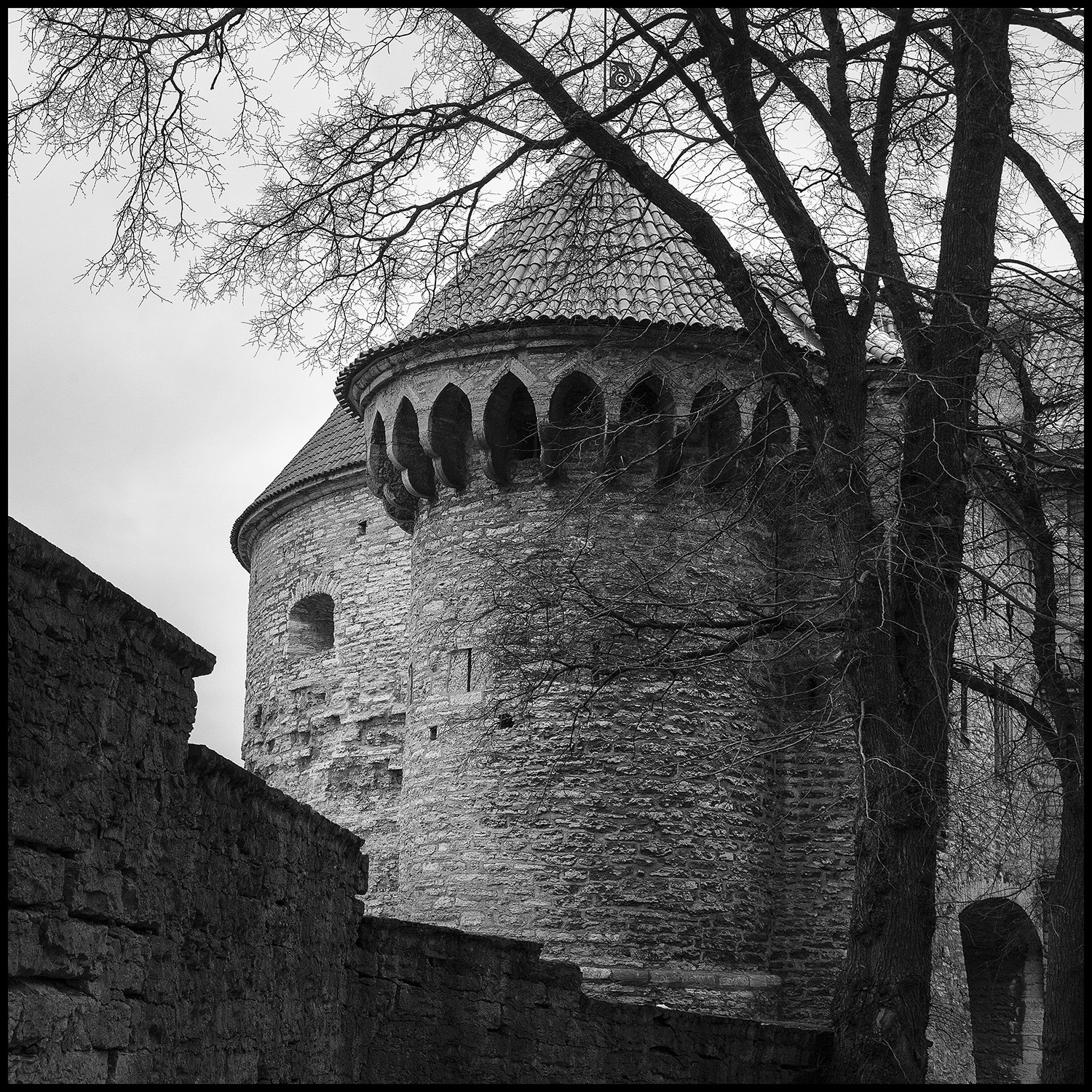
After the source material was prepared and cleaned, the DT Heritage team set about creating the images using the DT Atom digitization platform paired with the Phase One iXG camera system.
The DT Atom is a tabletop platform that’s compact, flexible, and portable — perfect for this project because on-site personnel had to move the whole setup from one location to another. The team swapped the standard reflective top for a DT Film Scanning Kit, which delivers high-speed, FADGI 4-Star-compliant film scanning at incredible resolution and is many times faster than legacy scanning equipment.
Image capture came from the 100MP Phase One iXG camera, which is designed expressly for cultural heritage environments with high-volume production needs. The camera renders crucial precision focus and the highest possible resolution and color accuracy at speeds not possible with DSLRs.
One of the many reasons the iXG camera was right for this project is because of its ability to autofocus. Glass-plate negatives can vary in thickness and often require refocusing from piece to piece. The iXG’s autofocus feature makes this process faster, more consistent, and easier for the technician.
This hardware setup allowed for the safest and most efficient material handling, limiting the amount of time each asset was handled and exposed to light.
The National Geographic Society was recently awarded a National Endowment of the Humanities grant to digitize their collection of over 15,000 Autochromes, Dufaycolor, Finlaycolor, and Agfachrome glass plates from around the world, many of which were never published and therefore only seen by a small number of people. The subject of these images include exploration, fieldwork, historic figures, and known cultural heritage sites.
The mosaic color screen processes on glass were in use by National Geographic by the early 1910s and were the primary means for capturing color photographs until they became obsolete shortly after the introduction of Kodachrome in 1935. Digitizing this collection will allow for more research and intellectual conversation surrounding the collection’s processes and content.
Unfortunately, these relatively rare color mosaic processes don’t have widely available digitization standards. To ensure the greatest success of this project, Digital Transitions worked with National Geographic to develop a materials-specific workflow and collection-specific image quality standards. Together, we digitized a small number of these plates to determine how to best capture the mosaic processes reflected in each image.

Spanish Woman Posing With a Fan, by Jules Gervais Courtellemont
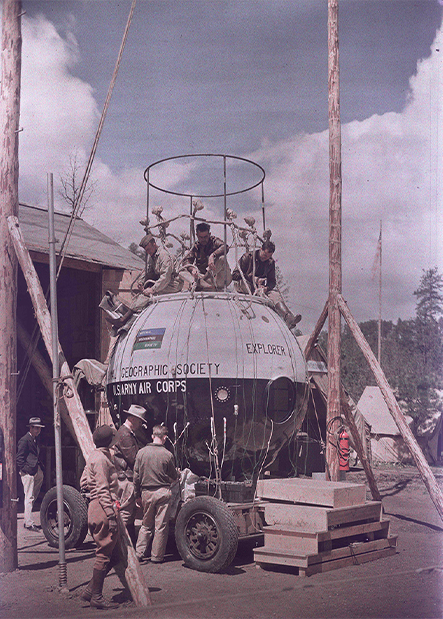
The Stratosphere Gondola, by Richard H. Stewart
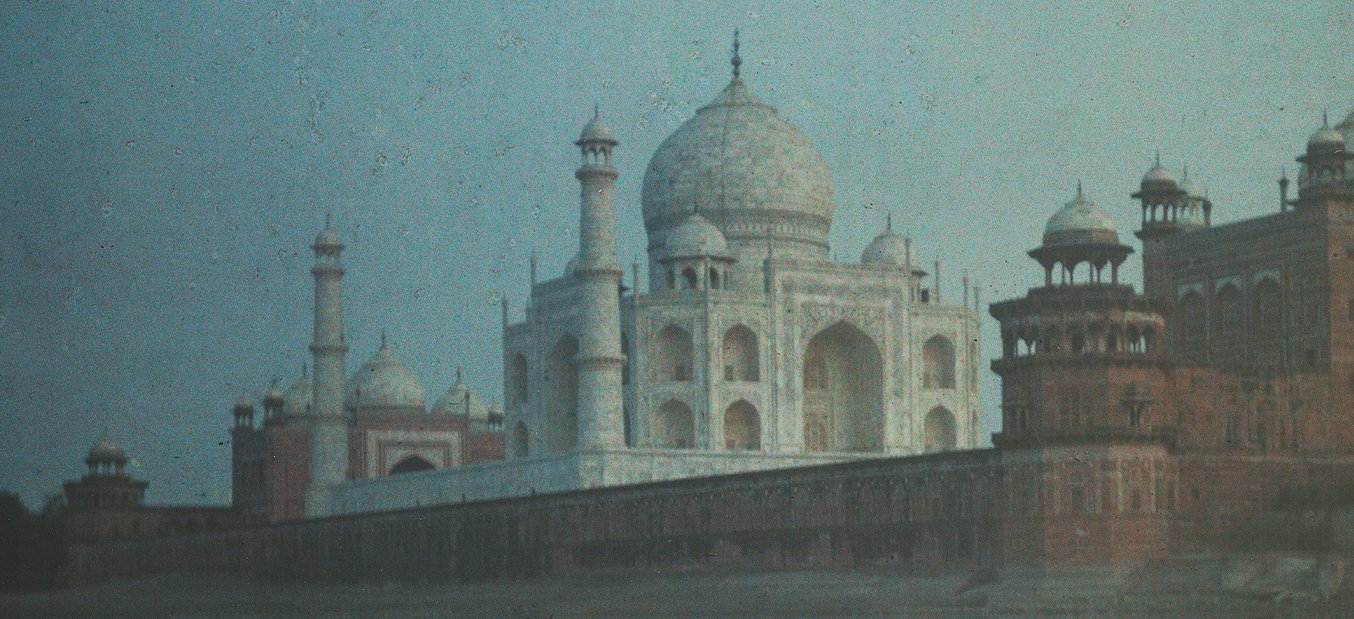
The Taj Mahal, by Jules Gervais Courtellemont
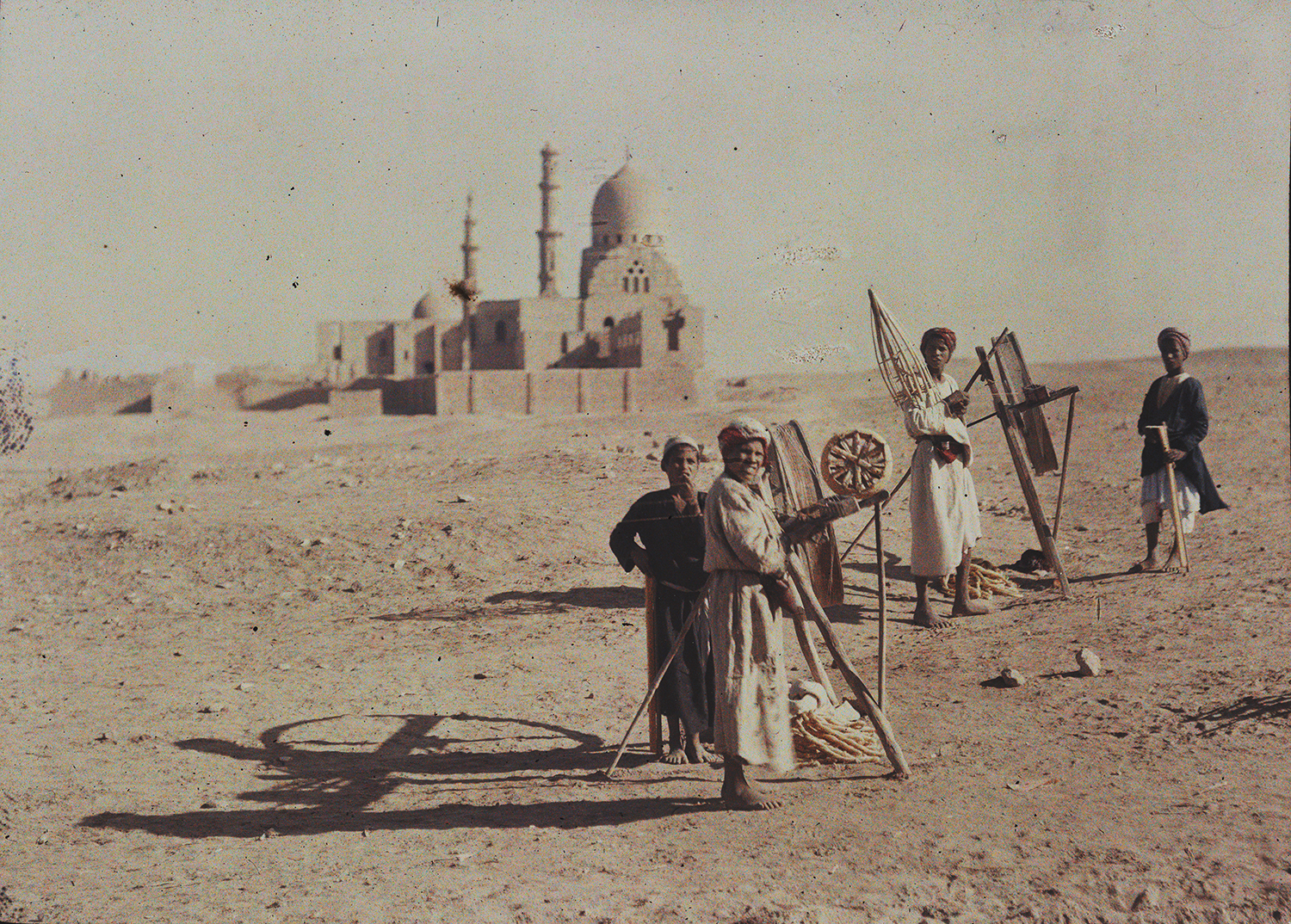
Textile Spinners in Egypt, by Jules Gervais Courtellemont
To capture the inherent dye cloud or color grid, which is necessary for a true preservation-grade digital representation, we needed a resolution of 3400ppi. This would require a 6-shot stitch on a 100MP camera for each 5×7 negative – or a 4-shot stitch using a 150MP camera.
Ultimately, the team opted to digitize the collection with the Phase One iXH 150MP camera on a DT Atom equipped with the Film Scanning Kit and DT Photon LED lighting. This hardware set-up allowed for the safest and most efficient material handling, limiting the amount of time each photograph is handled and exposed to light.
The resulting images of each batch will be run through our DT BatchScript script for bulk stitching in Adobe Photoshop creating the final digitized file – a FADGI-approved, 16-bit TiFF file! A smaller JPG will also be exported for user access.
Even with such fragile materials, the team is anticipating to image and process at least 120 plates per day!
We’re thrilled to have the opportunity to consult with and work together with The National Geographic Society on this project and can’t wait to share the results!
Video Library
Film Scanning Kit
Watch this video to learn more about the DT Film Scanning Kit and what sets it apart from a legacy scanning system.
Film Scanning in the Modern Era
Have you ever wondered about the unique and intricate process of digitizing and preserving film using a camera? In this session, DT technical specialist Arnab Chatterjee covers the fundamentals of film digitization using the DT Film Scanning Kit. Learn the basics of capture, lighting, and image processing.
Imaging Kodachrome and Ektachrome at National Geographic
The National Geographic Society holds some nine million 35mm color slides, the vast majority of which are Kodachrome and Ektachrome film. In National Geographic’s endeavors to continually improve our color management and overall imaging quality, they acquired color targets for both types of film, and with help from DT, created a set of custom ICC profiles. Along with a brief history of National Geographic’s use of color film, Julie McVey discusses their decision to pursue custom profiling, the initial testing and results of both the Kodachrome and Ektachrome profiles, and the evaluation of efficacy in our slide digitization workflow. Julie also addresses the pros and cons of creating custom ICC profiles for color film digitization. Download a copy of the color profiles for Kodachrome and Ektachrome Film here.
Early Color Photography at National Geographic
The National Geographic Society Archives holds the largest collection of early color photography in the United States: over 15,000 glass plate autochromes, Agfachromes, Dufaycolor, Finlaycolor photographs. The collection includes not only natural color photographs from Greenland to Japan, but also several notable color photographic “firsts.” The majority of the collection is currently undigitized and unpublished. This presentation discusses the process of taking the National Geographic Society’s ideas for digitizing these unique cultural heritage objects from “what-if?” to creating a fully-funded federal grant project to conserve and digitize the entire collection in partnership with DTCH and the Center for Conservation of Art and Historic Artifacts (CCAHA).
Reproducing the Negative – Rendering Considerations and Solutions
Best practices for digitizing film and other transmissive media have been well established through FADGI, Metamorfoze, and (upcoming) ISO guidelines. While they are technically demanding at the highest level, the capture process is relatively straightforward procedurally. However, there are certain variables in both capture and processing negatives that can greatly impact image rendering, even if these guidelines are met. We discuss two such variables and approaches to control them. First, we explore appropriate lighting considerations for the proper rendering of film as a 3-dimensional physical object and then examine appropriate processing considerations for the rendering of film as a container of image content.
The Digitization of New York Public Library’s Carl Van Vechten Slide Collection
An inside look into the New York Public Library’s project to digitize their collection of slides by Dance Critic, Novelist, Journalist, and Photographer Carl Van Vechten. His preoccupation with the dance performers of his day led him to capture thousands of unique and colorful images. This video takes a look into the process of digitizing over 800 of these slides using the highest-quality digitization equipment available. Read more about the project here. Images courtesy of Carl Van Vechten photographs ©Van Vechten Trust
Digitization Film with The Art Institute of Chicago’s Imaging Archive
This case study explores how the Art Institute of Chicago’s Imaging Archives used solutions from DT Heritage to digitize their collection of rare and delicate film material. For this particular project, the Archives focused on degrading, large format cellulose acetate negatives that showed symptoms of vinegar syndrome and channeling. An instant capture methodology that forgoes flattening the friable negatives between glass was deemed the safest and most efficient way to digitize these materials before their content was lost to further physical deterioration.
DT Reel Film Top for the DT Atom Product Demo
The DT Reel Film Top allows DT system users to scan a variety of reel film ranging in size from microfilm (smaller than 35mm) to large format aerial film.
Switching the DT Atom to transmissive imaging is very simple to do. Watch how you can easily set the film scanning stage on the DT Atom
Transmissive Workflows
Check out our digitization guide on efficient workflows when working with transmissive material. This document discusses the theory and practice of the preservation-grade digitization of transmissive materials. While the discussion of theory is informative regardless of the hardware and software used, the discussion of practice is in the context of solutions provided by the Digital Transitions Division of Cultural Heritage. While we are a commercial entity, our first and primary mission is to further the cause of Cultural Heritage Digitization. We hope you find that this document helps you fulfill that mission for your institution’s transmissive material collections.
Click here to learn more about our transmissive workflows guide.

